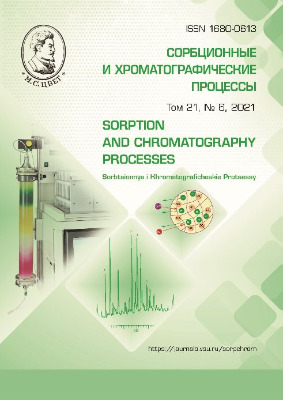Study of the thermal properties of organo-inorganic composites with quaternary amino groups based on magadiite
Abstract
Magadiite is a layered silicate, the layers of which consist of SiO4 tetrahedra and hydrated mobile cations located between these layers; in most cases, these cations are sodium cations. Its structure contains 3 layers of silicone tetrahedrons. The presence of mobile sodium cations in magadiite in the interlayer space makes it capable of chemical modification. The synthesis of organo-inorganic composites can be carried out through the grafting of aminosilanes to the interlayer hydroxyl groups of magadiite. The inorganic base in the form of layered magadiite will allow to use these composites in a wider temperature range than their organic counterparts (anion exchangers). The aim of this study was the investigation of the thermal properties of organic-inorganic composites with quaternary amino groups based on magadiite.
The objects of study were organo-inorganic composites with quaternary amino groups based on magadiite HMMCl (magadiite modified with N-trimethoxysilylpropyl-N, N, N-trimethylammonium chloride) and HMMI (magadiite modified with N-dimethylmethoxysilyl-N-trimethylammonium iodide).
The thermal properties of the synthesized composites were investigated using the thermogravimetric analysis (TGA) and "in situ" DRIFT- spectroscopy in the process of continuous heating of samples until certain temperatures were reached. The choice of temperatures for the IR study was determined by the position of the maxima on the thermograms of hybrid materials.
It was proposed that the process of decomposition of organo-inorganic composites with quaternary amino groups based on magadiite consists of dehydration, destruction of the grafted organic layer with the restoring of free silanol groups, decomposition of hydrogen-bonded silanol groups with their further dehydroxylation. The maximum temperature up to which the studied hybrid materials retain their properties is T≤130°C, which is almost twice higher than the temperature of the organic analogues – anion exchangers.
Downloads
References
Beneke K., Lagaly G., Weiss A., Ameri-can Mineralogist, 1975, Vol. 60, pp. 642-649. Available at: http://www.minsocam.org/ammin/AM60/AM60_642.pdf
Fletcher R.A. Bibby D.M., Clays and Clay Minerals, 1987, Vol. 35, No 4, pp. 318-320. DOI: https://10.1346/CCMN.1987.0350410.
Brindley G.W., American Mineralogist, 1969, Vol. 54, pp. 1583-1591. Available at: http://www.minsocam.org/ammin/AM54/AM54_1583.pdf
Hipassia M., Mouraa Heloise O., Pastore Dalton Transactions, 2014, Vol. 43, pp. 10471-10483. DOI: https://10.1039/C3DT53571A.
Supronowicz W., Roessner F., XVIIth Zeolite Forum, Bedlewo, 2010, pp. 53-58.
Borbély G.H. Beyer K., Karge G., Schwieger W. et al., Clays and Clay Miner-als, 1991, Vol. 39, No 5, pp. 490-497. DOI: https://10.1346/CCMN.1991.0390504
Shinobu Okutomo, Kazuyuki Kuroda, Makoto Ogawa, Applied Clay Science, 1999, Vol. 15, Iss. 1-2, pp 253-264. DOI: https://10.1016/S0169-1317(99)00010-1.
Sea-Fue Wang, Ming-Liang Lin, Yaw-Nan Shieh, Yuh-Ruey Wang, Shea-Jue Wang, Ceramics International, 2007, Vol. 33, Iss.4, pp 681-685. DOI: https://10.1016/j.ceramint.2005.12.005.
Rômulo B. Vieiraa, Pedro A.S. Mourab, Enrique Vilarrasa-Garcíab, Diana C.S. Azevedob, Heloise O., Pastorea Journal of CO2 Utilization, 2018, Vol. 23, pp. 29-41. DOI: https://10.1016/j.jcou.2017.11.004.
Kotova D.L., Selemenev V.F., Ther-micheskiy analys ionnoobmennikh materialov, M., Nauka Publ., 2002, 156 p.
Nefedova T.N., Thomé A.G., Schroe-ter F., Selemenev V.F. et al., Sorbtsionnye i Khromatograficheskie Protsessy, 2017, Vol. 17, No 5, pp. 741-749. DOI: https://10.17308/sorpchrom.2017.17/434.
Norman B. Colthup, Lawrence H. Daly, Stephen E. Wiberley Introduction to Infrared and Raman Spectroscopy, 2nd Edition, Academic Press, 1975, 536 p.







